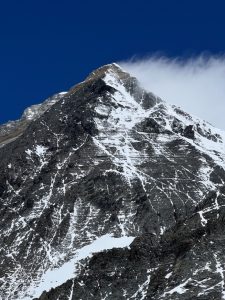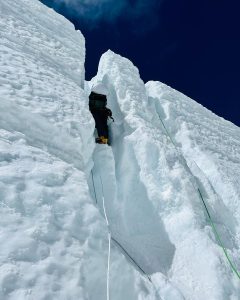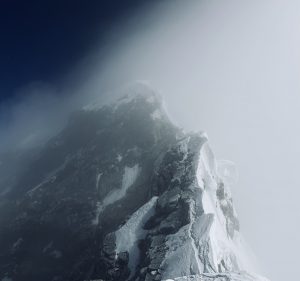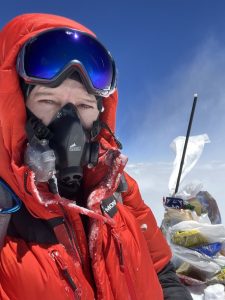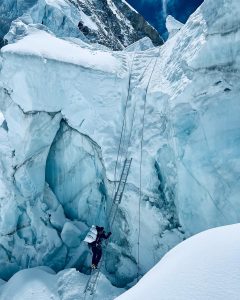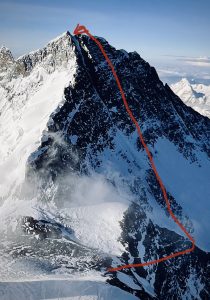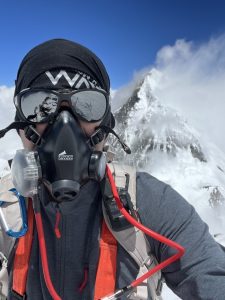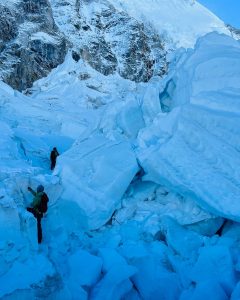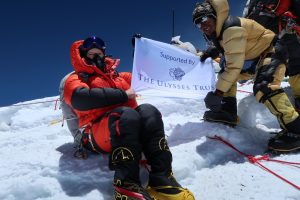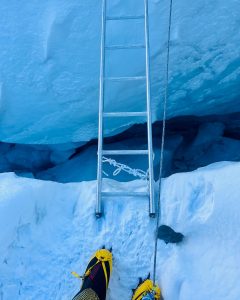‘You don’t get to the top of Mount Everest by coincidence’ – Major Garth Miller, London Guards
On 02 May 2022, Major Garth Miller from the 1st Battalion London Guards, left the UK bound for Nepal. He returned just 21 days later, having summited not only Everest itself, but also Lhotse (the 4th highest mountain in the world) in what is considered to be record time.
This year marks the 100th anniversary of the first expedition to attempt to climb Everest. It also marks the 30th anniversary of the Ulysses Trust, which itself was set up following an army reserve expedition to Everest in 1992. It was a privilege to carry the Ulysses Trust flag to the top of the world to commemorate both events!
Aim of Expedition Everest 100
The 3 primary objectives of Everest 100 were:
- Set a ‘Fastest Known Time’ (FKT) from London > Everest summit > London.
- Complete a ‘high double’: linking 2 x 8000m peaks in a single expedition.
- Creating a leadership learning package for schools, Reserve and Cadet Forces, UOTCs and military training establishments
The first was achieved by safely summiting Everest just 2.5 weeks after leaving the UK and returning to the UK within 3 weeks. The ‘High Double’ was achieved by linking the two 8000m peaks of Everest and Lhotse within 24hrs. The leadership package has thus far reached 100s of school children and military instructors, helping develop the characteristics of leadership, determination, resilience, and self-discipline.
During the lead up to the expedition it was a great privilege to share the expedition with hundreds of school children, working to inspire them to set their own goals and devise a strategy to achieve them. The example of conquering Everest was a way to help them see a way through their own struggles and challenges. These presentations, with focus on a military audience of cadets, reservists, and those under training, will continue.
The expedition was billed as a ‘Lightning Ascent’, aiming to slash the 9-week duration of a typical Everest expedition by more than half. To overcome the challenge and risk of compressing that timeframe required months of physical preparation which included pre-acclimatisation at home and in the gym. This acclimatisation was achieved using technology which simulated high altitude to kick start the physiological changes that take place during expeditions to the high Himalayas. Due to the months of preparation required and the increased exposure to risk associated with lightning ascent, the team consisted of me and just two sherpas (Pasang and Dorje). The extra sherpa support mitigated some of the risk by enabling us to carry emergency oxygen and spares for our oxygen apparatus.
Despite having to delay our summit attempt by 2 days due to challenging weather conditions, the expedition went according to plan. The pre-acclimatisation process worked well, and I arrived at base camp (5300m) ready to go. The process of climbing 8000m peaks involves a series of ‘rotations’ up the mountain, gaining more altitude with each multi-day foray above base camp, as the body adapts to the thin air. The lightning ascent did not mean that I moved faster than others on the mountain, rather it involved reducing the number of these rotations. This not only saved time, but it reduced the number of times I had to climb through the dangerous Khumbu Icefall – a tumbling glacier which claims the lives of mountaineers and sherpas every year. The cacophony of tonnes of crashing blocks of ice in the icefall and the swooshing of avalanches was a constant companion in base camp and on the lower reaches of the mountain.
The Route – Base Camp to Camp 1
Base Camp, situated on the Khumbu glacier, is a unique tented town and temporary home to about 1000 climbers, sherpas, cook staff, porters, and medical specialists. It appears for 3 months each year during the Everest climbing season and is a fascinating, if uncomfortable, melting pot of cultures. From here, our route took us into the Icefall, an objectively hazardous climb from 5300m to 6000m. This is perhaps the most dangerous part of the climb, with the entire route threatened by the potential of collapsing blocks of ice ranging in size from a small car to the size of a bungalow! To minimise the risk of a serac collapse, this part of the route is usually tackled at night when the temperatures are at their lowest. The route is crossed innumerable crevasses and is constantly changing as the ice moves. The smaller crevasses can be jumped, but many require the use of aluminium ladders which are tied together and laid across the apparently bottomless gaps. These certainly focus the mind! Once clear of the icefall, the route takes us into the incredible amphitheatre of the Wester Cwm – a three kilometre long glacial valley flanked on both sides by the imposing Himalayan giants of Everest and Nuptse. It is a relief when we finally see Camp 1, situated at 6050m, a safe distance from the top of the icefall.
The Route – Camp 1 to Camp 3
From Camp 1 the route weaves its way through the crevasses of the Western Cwm. The gradient is gentle, ascending around 400m in total between Camp 1 and Camp 2. This section is just a walk but, weighed down with our summit equipment and in the stifling reflected heat from all sides, it remains hard going. We recorded temperatures of over 35C in the Western Cwm. We spent several nights at Camp 2 waiting for weather conditions high on the mountain to improve. Camp 2 is the launching point for the ascent of the impressive Lhotse Face, a mile high section of consistently steep ice. Camp 3 is perched precariously in the middle of this ice wall at around 7400m. With tent platforms carved out of the ice, it is a dangerous and uncomfortable place to spend the night. In the thin air above Camp 3 oxygen becomes a necessary aid. Without oxygen the mountain is simply unclimbable for all but the most elite professional mountaineers.
The Route – Camp 3 to Camp 4
We continued out of Camp 3 on the Lhotse Face in a steep upward traverse and through the awkward mixed rock and ice of the Geneva Spur. As we round the top of the spur we get our first glimpse of the South Col, a large flat area of ice at 8000m upon which Camp 4 is situated. This desolate, windy, and inhospitable place will be home for just for several hours until it is time to set out for the summit. Here we melt snow to hydrate, prepare and check our equipment and try to get a few hours rest. From here, at and above 8000m, we are in the ‘Death Zone’ – where the pressure of oxygen is insufficient to sustain human life. If it was possible (and it isn’t!) for a helicopter to land an unacclimatised person here on the South Col without oxygen they would fall unconscious within a few minutes, and death would soon follow.
The Route – Camp 4 to the summit
We had planned to leave Camp 4 for the summit at 8pm, positioning us ahead of any slower climbers. As we woke to get ourselves ready it was immediately obvious that the wind was out of safe limits for climbing. We spoke with other sherpas and compared weather forecast data. It seemed that there might be a lull in the winds above 8500m early the next morning. Our plan was to wait until 0145 in the morning before attempting our final climb, whatever the wind at the South Col, in the hope that the winds on the exposed summit ridge would abate by the time we get there.
We woke to almost calm winds and quickly and efficiently got underway, across the hard flat ice of the South Col. Soon we were on the steep snow slopes which would take us to the Balcony at 8400m. Here we would stop for a few minutes to fuel and hydrate, change our oxygen bottles, and as the sun rose we got our first glimpse of the surprisingly steep and exposed summit ridge. From view was spectacular and through poking through the blanket of cloud below us were the summits of Kanchenjunga, Lhotse and Makalu – the 3rd, 4th, and 5th highest mountains in the world.
I took a moment to assess our situation. I was well rested, hydrated and had managed to eat well at the South Col. We had sufficient oxygen, and both Pasang and Dorje looked strong. The wind was calm, and the weather looked stable. My fingers and toes felt warm, and the route ahead looked manageable in terms of technical difficulty. This was it – the only reason that I would not summit was if I gave up, and I certainly wasn’t going to do that!
From the Balcony the route follows the Southeast Ridge, along a mix of knee-deep snow and rocky outcrops, to the South Summit of Everest at 8750m. I had read from here that Everest climbers know that the summit is ‘in the bag’, but I wasn’t so sure. The wind was picking up and the clouds began to swirl around us. I could feel the air temperature drop dramatically. We changed Oxygen bottles for the final summit push and discovered that my new bottle had leaked – leaving me without oxygen for what seemed like an eternity as we worked the problem, eventually finding a bottle that, if used sparingly, had sufficient oxygen to get me to the top and back to the South Summit at least. It was a desperately uncomfortable few minutes, and I couldn’t help but think back to my previous attempt on Everest which ended at a similar altitude when my oxygen system failed completely. Looming above us was the famous ‘Hillary Step’. This now seemed like an impassable obstacle, a near vertical rocky and icy climb at around 8800m. From my vantage point I could make out a dead body at the bottom of the Hillary Step, one we would have to step over to tackle the climb. The situation looked desperate.
The Hillary Step was tough. My crampons clawed awkwardly at the rock as I struggled to the top of the 20m obstacle. This section took every ounce of my remaining energy and determination. I knew that if I could crack the Hillary Step, I will have broken the back of the climb. Although the summit is not visible from the top of the Hillary Step, I could sense that it was tantalisingly close. I just had to keep going and not give up.
We were to pass one more dead body close to the summit but, nine hours after setting out from Camp 4, Pasang and I had ‘run out of up’ and found ourselves on top of the world. We had summit to ourselves. Pasang attached a prayer flag to the summit cairn and knelt in prayer. We hugged and congratulated each other on our summit. It was an indescribable feeling. We were joined later by Dorje and a handful of other climbers, and it was fantastic to share the summit experience with them. After 45 minutes or so we began our climb back down to the South Col where we would rest for 12 hours before setting off for our next summit – Lhotse, the fourth highest mountain in the world.
The Route – Lhotse
For Lhotse we retraced our steps over the Geneva Spur, but rather than turn down towards Camp 3 we would turn up – directly up the Lhotse Face. Although technically straightforward, the climb was long and brutally steep. Almost entirely on snow and ice, the route followed a couloir directly to the summit at 8516m. The 600m couloir felt incredibly dangerous. Most of the two dozen or so deaths that have occurred on Lhotse happen here, the result of rockfall or simple falls. With our oxygen turned up as far as it would go, we climbed up the couloir for 5hrs without a break. We didn’t want to spend a minute longer on the route than we had to. I could feel the bruising to my feet as I repeatedly kicked into the ice, and our muscles burned from exertion. Dorje was exhausted after Everest and did not have enough left in his tank to tackle Lhotse with us. It was swelteringly hot and a few hundred metres from the top Pasang and I had to strip off our heavy high-altitude clothing, and tie everything we wouldn’t need for the final climb to an anchor in the snow. As we reached the final rocky pyramid, I was shocked to find yet another dead body just below the summit. This poor individual had died several years ago, most likely the result of exhaustion. A reminder if one were needed that the summit is only halfway.
Summary
The Everest climbing season is short – with the mountain usually only climbable during the so called ‘summit window’, a 7–10-day period in May. This year saw an unusually long summit window, allowing 250 non-Nepali climbers, and over 300 Sherpas to summit. With 3 deaths on Everest and a further death on Lhotse, 2022 will be classed as a safe and successful year. Even with all those summits at no point did the mountain feel busy. We experienced no queues, and our small team of three even had the summit to ourselves before a handful of other mountaineers arrived. In fact, when we did meet other climbers there was a great feeling of community and of sharing the same challenge. It was without doubt an incredible experience, I loved the challenge of controlling what was controllable, and making decisions on the mountain to make sure that we were managing risk. It was a satisfying mix of climbing, mental chess, gambling with luck, and just plain hard work that got us to the summit.
Within a week of reaching the summit things were very much back to normal – my lingering cough has cleared up, I was back at work, and even doing the weekly shop at Tesco. The top of the world seems far away now, but I can vividly recall those final few steps to the summit and feel that incredible sense of achievement that comes with achieving personal goals. I’m excited about sharing my ‘Everest 100’ story with Cadet and Reservist units to bring out the key themes of leadership, resilience, and determination. I hope to build on this expedition and return to the high Himalayas with an entirely reservist team soon.
Without a grant from the Ulysses Trust the expedition would have been in jeopardy. The extra oxygen and sherpa support that they funded unlocked the summit by reducing the risk to an acceptable level. I would recommend that any cadet or reserve unit planning to undertake an expedition or adventurous training to contact the Ulysses Trust early – they have a genuine enthusiasm to provide support!
Climbing Everest isn’t for everyone. The risks and dangers that sit outside of the mountaineer’s control are extreme. But I would unreservedly encourage people to set themselves fantastic goals. I found great personal satisfaction in the journey. Meeting new people, learning new things, pushing myself beyond what I thought was possible was more rewarding that I had expected. The summit really was just the icing on the cake. The key thing I’ve learnt is that we can all do something extraordinary if we commit and really put our minds to it. Back yourself and don’t give up. If you never try, you’ll never know…
Thank you.

